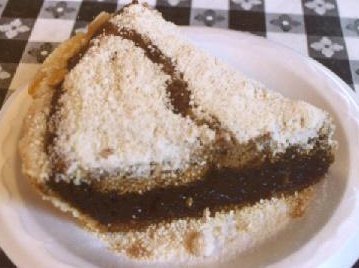Part Pie – Part Coffee Cake – Absolutely Delicious!
Visit the Lancaster area of Pennsylvania and indulge in a Pennsylvania Dutch original, the Shoofly Pie. Also know as Shoo-Fly Pie, and Shoo Fly Pie.
Most of the area restaurants and bakeries sell this favorite pie. The pie is more like a coffee cake, with a gooey molasses bottom. Some cooks put chocolate icing on top for a chocolate shoofly pie. Some use spices – some do not. Today, the biggest debate being whether to use a flaky or a mealy crust for the pie dough. The bottom of the pie can be thick or barely visible and is referred to as either a “wet bottom” or a “dry bottom.” Everyone agrees the shoofly pie is best when slightly warmed and with whipped cream on top. If you like sweet desserts, you will probably love shoofly pie!
Check out What’s Cooking America’s Shoofly Pie (Wet Bottom) recipe.
Photo taken at the Yoder’s Deitsch Haus restaurant in Montezuma, GA.
History of Shoofly Pie:
Pennsylvania Dutch cooking is indigenous to those areas of southeastern Pennsylvania that were settled by the Mennonites and Amish. William Penn (1644-1718), founder of Pennsylvania, was seeking colonists for the Pennsylvania area.
1730 – The Amish and Mennonites both settled in Pennsylvania as part of William Penn’s “holy experiment” of religious tolerance. He wanted to establish a society that was godly, virtuous and exemplary for all of humanity. Encouraged by William Penn’s open invitation to persecuted religious groups, various sects of Christian Anabaptists-Mennonites and offshoots such as the Amish and the Brethren-emigrated from Germany and Switzerland. The first sizeable group arrived in America around 1730 and settled near Lancaster County, Pennsylvania.
These settlers were addicted to pies of all types and they ate them at any time of day. The most famous of their pies is the shoofly pie. As the very earliest settlers came to North America by boat, they brought with them the staples of their diet – long-lasting nonperishable that would survive a long boat trip. These staples were flour, brown sugar, molasses, lard, salt, and spices. Arriving in the new land during late fall, they had to live pretty much on what they had brought with them until the next growing season. The women, being master of the art of “making do,” concocted a pie from the limited selection that could be found in the larder. This resourcefulness led to the creation of shoofly pie.
Shoofly pie seems to be a variation of the older Treacle Tart. Treacle is the British generic name for any syrup made during the refining of sugar cane; i.e., Treacle, Black Treacle, Molasses, Golden Syrup and Blackstrap are all treacles. During the 17th century, treacle was used chiefly as a cheap from of sweetener. By the late 1700s, refined sugar became affordable to the masses in Britain and overtook treacle as a general sweetener. Molasses was often substituted for treacle in colonial American recipes. Many early cookbooks have Molasses Pie recipes.
First time visitors to the area always comment on this pie and its strange name:
The origin of the name has been debated for years and will probably never ultimately be solved. The most logical explanation is related to the fact that during the early years of our country, all baking was done in big outdoor ovens. The fact that pools of sweet, sticky molasses sometimes formed on the surface of the pie while it was cooling, invariably attracting flies, show how such a pie could come to be called Shoofly Pie.
To Return to my main History Index Page, click HERE.
Comments from readers:


One Response to “Shoofly Pie History”
Robin Parsons
I’m PA Dutch and my family immigrated in the 1700’s from Germany and Switzerland to southcentral and southeastern PA. Please note that most PA Dutch who came over were German Reformed (now United Church of Christ) and Lutheran — not Amish and Mennonite. My mother still speaks PA Dutch but, due to WWII, our generation was not taught the language which is a form of low German. I do cook and bake our foods from scratch and keep our traditions. In May I’ll be visiting some of the towns in Germany and Switzerland from which my ancestors emigrated so long ago.